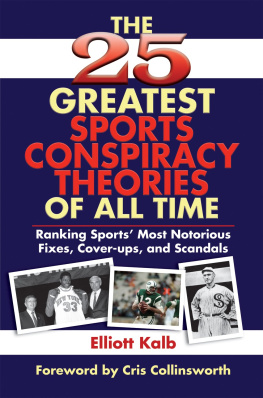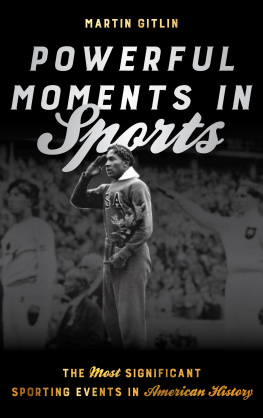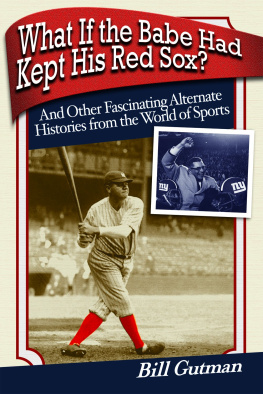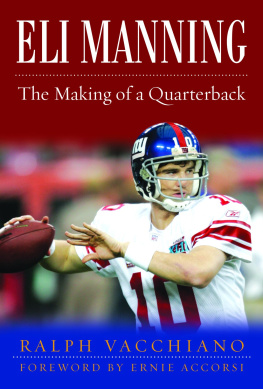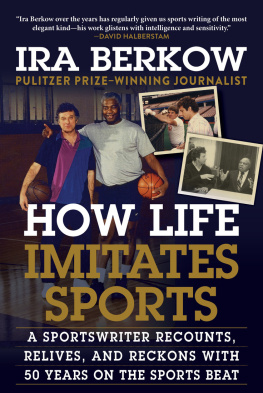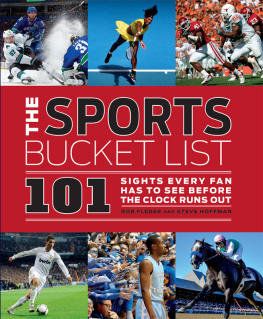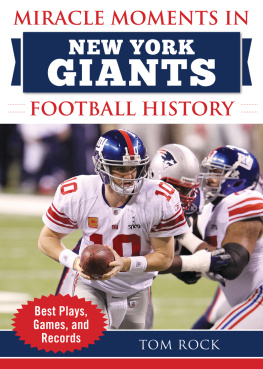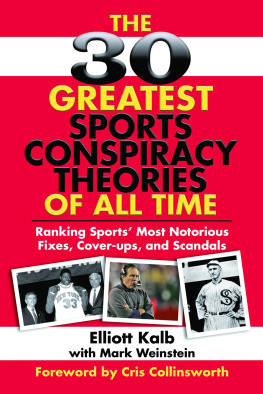Stuart Miller is coauthor of The Other Islands of New York City and author of Good Wood: The Story of the Baseball Bat and Where Have All Our Giants Gone? He has written about sports for 30 years, and his work has appeared in the New York Times, the Sports Business Journal, the Wall Street Journal, ESPN, Sports Illustrated, Sporting News, and numerous other publications. He lives in Brooklyn with his wife and two sons.
A bibliography is going to be somewhat limited for a book like this. Much of my research came from newspapers and magazines (local and national), especially contemporary sources for each event, and where I could I also watched as much footage as possible. I also relied heavily on statistical websites, especially Baseball-reference.com and its brethren. For the first edition of this book I also interviewed almost 20 experts on sports, from tennis to boxing to baseball; many of their insights still inform this material. There were, however, some exceptional books, newspapers, and magazines that helped along the way. The following is a selective list.
Cohen, Stanley. The Game They Played. New York: Farrar, Straus and Giroux, 1977.
DAgostino, Dennis. Garden Glory: An Oral History of the New York Knicks. Chicago: Triumph, 2003.
Daily News
Deford, Frank. Big Bill Tilden: The Triumphs and the Tragedy. New York: Open Road Media, 2011.
Drucker, Joel. Jimmy Connors Saved My Life: A Personal Biography. Wilmington, DE: Sport Media Publishing, 2004.
Eig, Jonathan. Luckiest Man: The Life and Death of Lou Gehrig. New York: Simon and Schuster, 2005.
Einstein, Charles. Willies Time: A Memoir. New York: Lippincott, 1979.
Eisenberg, John. The Great Match Race: When North Met South in Americas First Sports Spectacle. Boston: Houghton Mifflin Harcourt, 2006.
ESPN
Kahn, Roger. The Boys of Summer. New York: Harper and Row, 1972.
Kram, Mark. Ghosts of Manila: The Fateful Blood Feud between Muhammad Ali and Joe Frazier. New York: Harper, 2001.
Kriegel, Mark. Namath: A Biography. New York: Penguin, 2005.
New York Post
New York Times
Newsday
Sperber, Murray. Shake Down the Thunder: The Creation of Notre Dame Football. Bloomington: Indiana University Press, 2002.
Sporting News
Sports Illustrated
Tygiel, Jules. Baseballs Great Experiment: Jackie Robinson and his Legacy. New York: Oxford University Press, 1983.
S erena Williams, arguably the greatest womens tennis player ever, was yet again closing in on history.
Williams had finished 2014 by winning the U.S. Open and the WTA Finals. She started 2015 by winning the Australian Open. En route to winning the Miami Open, she won her 700th singles match, putting her in elite company with only Roger Federer and Rafael Nadal. Soon Williams accomplished something neither man had, capturing four straight majors with triumphs at Roland Garros and then Wimbledon. During the French Open, she also became the first Open-era woman to win 50 matches at each of the four Slams; by winning Wimbledon, she became the oldest Open-era woman to win a major and the first player to win four consecutive Slams twiceshe also achieved the feat in 20022003.
Only one task remained: win the Grand Slam, capturing all four majors in a calendar year. Only Martina Navratilova and Steffi Graf, Williamss two challengers for the greatest tennis player of all time, had won an Open-era Grand Slam. Winning in Queens would also tie Williams with Graf for most majors in the Open era.
The powerful, intimidating Williams seemed impervious to outside pressures. But she was also acutely aware of her place in tennis history, and while she was loathe to admit it publicly, the Grand Slam was on her mind. In 2014, without the same stakes, she won seven matches at the U.S. Open without losing more than four games in any set. This year was tenser. In the second round, she required a tiebreaker in the first set against qualifier Kiki Bertens; next she dropped the first set against wild-card Bethanie Mattek-Sands, then eked out a 75 second set before taking control in the third set. She also dropped a set against her sister Venus in their quarterfinal match.
Still, it was difficult, if not impossible, to see how Williams could be stopped. Her semifinal match was against Roberta Vincithe slight Italian doubles specialist was ranked 43rd in singles. She reached her first Slam semis in part through the good fortune of not having to play any seeded players. She had lost all four of her previous matches to Williams. Bookmakers placed the odds at 3001. Afterward, Vinci confessed that she didnt believe she could win either.

The indomitable Serena Williams was on the verge of completing a Grand Slam when she was stunned by Roberta Vinci at the U.S. Open. Author photo
Williams was expected to win, then finish her quest against second-seed Simona Halep, who Williams had beaten in six of their seven matches. On the off-chance that another unlikely Italian semifinalist, 26th-seed Flavia Pennetta, would surprise Halep, well, Williams had won all seven of those showdowns. (Pennetta did indeed shock Halep, 61, 63, just before the main event.)
Maybe after 33 straight wins at Grand Slam matches, the presumption of victory got to Williams. Maybe it was plain old-fashioned nerves, getting so close to a long-desired goal. Certainly, Vinci deserves plenty of credit for what was to follow: Smiling all the way, she stuck to her game plan of pestering Williams with defensive slices and offensive attacks of the net, where the longtime top-ranked doubles player won 18 of 25 points. She remained steady even as pressure on her mounted.
The first set seemed predictable. Despite body language that suggested lethargy, Williams did what she does best: She overpowered Vinci, 62, in a little more than a half-hour. She pounded 16 winners and made only eight unforced errors. That ratio changed dramatically the closer Williams got to the finish line: In the last two sets, Williams hit 34 winners but had 32 unforced errors. Vinci, by contrast, had only 20 errors the entire match.
Williamss footwork stagnated. Vincis low slices required Williams to move well to generate her own pace; Williams kept hitting hard, but she was often off-balance, leading to bad misses. Williams also played tight on both her serve and Vincis. In their previous match, Williams had pounded weak second serves, winning 60 percent of those points, while capturing 54 percent on her second serves. In the semis, Williams won just 49 percent on Vincis second serves and 45 percent of her own second serves.
Vinci could see Williams battling her nerves and kept pressuring her to make one more shot, one more shot again. When Williams missed a backhand to give Vinci the second set, 64, she smashed her racket in frustration, earning a code violation that she barely seemed to notice. Still, Williams was 181 in 2015, in three-set matches, and was the superior talent. When she broke Vinci to go up 20 in the final set, it seemed normalcy had returned. It had not.
Instead of consolidating the break, Williams choked, double faulting to lose the game. With the score tied at 33, Vinci played the quintessential point: She battled for 18 shots, sliced a backhand, charged the net, and turned Serenas running power backhand into a forehand drop volley to bring the game to deuce. Afterward, she put her hand to her ear and asked the crowd for some love. What about me? she said.


